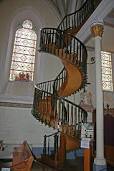- May 20, 2009
- 144,087
- 66,359
- 2,330
Am traveling through NM and CO and stopped in Santa Fe. Went to St Francis Chapel to pay my respects to my patron saint, then went to Loretto Chapel to see the Staircase.
The prior architect had died or was killed before completing the church leaving them only able to access the choir loft via ladders. The church had asked several other local architect for their input but they all insisted that due to lack of space and steep angle of access, ladders would be the only way to access the loft.
The Sisters prayed for 9 days to St Joseph, the patron saint of builders.
On the 9th day an old man came into town leading a donkey and presented himself to the Sister. His only tools were a saw, a mallet and a architect square. He offered to complete the church for them.
He worked alone, the Sisters never saw him at work. He never asked for pay. When done he simply vanished and was never seen again.
The staircase he built was a double spiral that looks like a Golden Ratio between the 2 turns.
There are 33 stairs.
There is not a nail or screw or glue, there are only wooden pegs
The wood used to make the stairs was not identified until 1997
There is no central support for the stair, no was there a bannister when it was first built. Engineers tell us that even if the stair were made of steel, they'd need a central support, Loretto Staircase does not have any

The prior architect had died or was killed before completing the church leaving them only able to access the choir loft via ladders. The church had asked several other local architect for their input but they all insisted that due to lack of space and steep angle of access, ladders would be the only way to access the loft.
The Sisters prayed for 9 days to St Joseph, the patron saint of builders.
On the 9th day an old man came into town leading a donkey and presented himself to the Sister. His only tools were a saw, a mallet and a architect square. He offered to complete the church for them.
He worked alone, the Sisters never saw him at work. He never asked for pay. When done he simply vanished and was never seen again.
The staircase he built was a double spiral that looks like a Golden Ratio between the 2 turns.
There are 33 stairs.
There is not a nail or screw or glue, there are only wooden pegs
The wood used to make the stairs was not identified until 1997
There is no central support for the stair, no was there a bannister when it was first built. Engineers tell us that even if the stair were made of steel, they'd need a central support, Loretto Staircase does not have any


